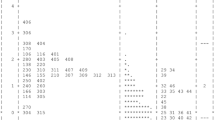Abstract
The current study investigated a needs assessment survey designed to measure perceptions of causes of dropout and school violence and related interventions. The needs assessment was conceptualized as a first step to be taken by schools to facilitate program planning, school-based implementation and acceptability of programs designed to prevent school violence and dropout. The research reported in this paper is a follow-up to a recently published comprehensive needs assessment regarding the prevention of school dropout and violence. Results compare survey administration in Michigan with the original sample in Georgia. The revised instrument was administered to a school district in Michigan, and the results supported the five-factor model proposed in the initial research. Those factors include: School Connectedness, Causes of Disruptive of Violent Behavior, Causes of School Disengagement/Dropout, Interventions for Violence and Interventions for Dropout. This article considers implications for future use of adapted versions of this needs assessment surveys in developing effective preventive interventions.
Similar content being viewed by others
References
Bronfenbrenner, U. (1989). Ecological systems theory. In R. Vasta (Ed.), Annals of child development (Vol. 6, pp. 187–249). Greenwich, CT: JAI Press.
Coie, J. D. Lochman, J. E., Terry, R., & Hyman, C. (1992). Predicting early adolescent disorder from childhood aggression and peer rejection. Journal of Consulting and Clinical Psychology, 60, 783–792.
Elliott, S. N., Witt, J. C., & Kratochwill, T. R. (1991). Selecting, implementing, and evaluating classroom interventions. In G. Stoner, M. R. Shinn, & H. M. Walker (Eds.), Interventions for achievement and behavior problems (pp. 99–136). Silver Spring, MD: National Association of School Psychologists.
Finn, J. D. (1993). School engagement and students at risk. Buffalo, NY: State University, U.S. Department of Education, National Center for Educational Statistics. (ERIC Document Reproduction Service No. ED 362 322).
Frick, P., Kamphaus, R. W., Lahey, B. B., Loeber-Christ, M. G., Hart, E., & Tannenbaum, L. E. (1991). Academic underachievement and the disruptive behavior disorders. Journal of Consulting and Clinical Psychology, 59, 289–294.
Fullan, M. G. (1991). The new meaning of educational change (2nd ed.). New York: Teachers College Press.
Furlong, M., Morrison, G. M., Chung, A., Bates, M., & Morrison, R. (1997). School violence. In G. G. Bear, K. M. Minke, & A. Thomas (Eds.) Children’s needs II: Development, problems and alternatives. Bethesda, MD: National Association of School Psychologists.
Grannis, J. C. (1991). Meeting the goals of school completion. New York: ERIC Clearinghouse on Urban Education (ERIC Document Reproduction Service No. ED 334 309).
Greenwood, D. J., Whyte, W. F., & Harkavy, I. (1993). Participatory action research as a process and as a goal. Human Relations, 46, 175–192.
Gutkin, T. B., & Curtis, M. J. (1999). School-based consultation theory and practice: The art and science of indirect service delivery. In C. R. Reynolds & T. B. Gutkin (Eds.), The handbook of school psychology (pp. 598–637). New York: Wiley.
Hinshaw, S. (1992). Externalizing behavior problems and academic underachievement in childhood and adolescence: Causal relationships and underlying mechanisms. Psychological Bulletin, 111, 127–155.
Ho, B. S. (2002). Application of participatory action research to family-school interventions. School Psychology Review, 31, 106–121.
Hunt, M. H., Meyers, J., Davies, G., Meyers, B., & Grogg, K. (2002). A comprehensive needs assessment to facilitate implementation of a dropout and violence prevention program. Psychology in the Schools, 39, 399–416.
Kazdin, A. E. (1980). Acceptability of alternative treatments for deviant child behavior. Journal of Applied Behavioral Analysis, 13, 259–273.
Kortering, L. J., Hess, R. S., & Braziel, P. M. (1997). School drop out. In G. G. Bear, K. M. Minke, & A. Thomas (Eds.). Children’s needs II: Development, problems, and alternatives (pp. 511–521). Bethesda, MD: National Association of School Psychologists.
Lincoln, Y. S., & Guba, E. G. (1985). Naturalistic inquiry. Beverly Hills, CA: Sage.
Meyers, J., & Nastasi, B. (1999). Primary prevention in school settings. In C. Reynolds & T. Gutkin (Eds.), The handbook of school psychology (pp. 764–799). New York: Wiley.
Nastasi, B. K., Varjas, K., Berstein, R., & Jayasena, A. (2000). Conducting participatory culture-specific consultation: A global perspective on multicultural consultation. School Psychology Review, 29, 401–413.
Nastasti, B. K., Varjas, K., Schensul, S. L., Silva, K. T., Schensul, J. J., & Ratnayake, P. (2000). The participatory intervention model: A framework for conceptualizing and promoting intervention acceptability. School Psychology Quarterly, 15, 207–232.
No Child Left Behind Act 2001, Pub. L. 107-110 (2001).
Patterson, G. R., DeBaryshe, B. D., & Ramsey, E. (1989). A developmental perspective on antisocial behavior. American Psychologist, 44, 329–335.
Sinclair, M. F., Christenson, S. L., Evelo, D., & Hurley, C. (1998). Dropout prevention for high-risk youth with disabilities: Efficacy of a sustained school engagement procedure. Exceptional Children, 65, 7–21.
Tolan, P. H., & Guerra, N. G. (1994). What works in reducing adolescent violence: An empirical review of the field. Boulder, CO: Center for the Study and Prevention of Violence, University of Colorado.
Truscott, S. D., Cosgrove, G., Meyers, J., & Eidle-Barkman, K. A. (2000). The acceptability of organizational consultation with prereferral intervention teams. School Psychology Quarterly, 15, 172–206.
Author information
Authors and Affiliations
Corresponding author
Rights and permissions
About this article
Cite this article
Miltich, A.P., Hunt, M.H. & Meyers, J. Dropout and Violence Needs Assessment: A Follow-up Study. Contemp School Psychol 9, 135–144 (2004). https://doi.org/10.1007/BF03340914
Published:
Issue Date:
DOI: https://doi.org/10.1007/BF03340914




